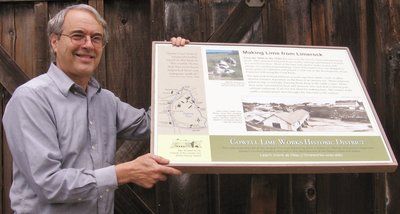Noted geologist Frank Perry has become a local Renaissance man of sorts. Not only has he been a standout leader on our annual geology walks along the San Lorenzo River — his third one will be June 18 — but he has signed on to create six outdoor interpretive signs at University of California, Santa Cruz.
As a leading expert in lime kilns, he has finished his first sign on a self-guided walk through the UCSC Cowell Lime Works Historic District.
At one time, our lime was promoted as being the best in the world because of its purity and was shipped by schooner, then by steamer and then, in 1908, by railroad to San Francisco.
As the city’s population exploded, development needed the mortar and plaster that Santa Cruz County lime could provide. Buildings that withstood the earthquake of 1906 still hold the geological heart of quarries in Scotts Valley and the Henry Cowell estate that are part of San Francisco’s historical architecture.
On the board of directors of the Friends of the Cowell Lime Works, Perry spends much of his time and energy on restoring the old lime kilns and historical buildings at the entrance to the UCSC campus, too.
“It’s the only place in California that still has a 19th-century lime-making plant that is still mostly intact, and it’s listed on the National Register of Historic Places,” he said.
On a recent Sunday morning, I found him and one of the UCSC interns in an old barn on campus figuring out a puzzle of old redwood planks on the floor that used to be the Cardiff House Shed. The Cardiff House, presently the Women’s Center, was home to the Henry Cowell family beginning in 1865, when Cowell supervised the lime kiln works.
The cookhouse, now serving as the admissions building, served up vittles to 50 workers or more, whose work included heating up kilns to 2,000 degrees Fahrenheit for as long as five days, which turned limestone — composed of ancient marine sediment — into lime. The kilns produced calcium carbonate alchemy.
Perry says, “The university bought the property from the Cowell Foundation, which still exists as a charitable organization, in the early ’60s.”
The definition of a Renaissance man is one “who has a wide range of accomplishments and intellectual interests,” according to the Encarta Dictionary. In addition to the lime works, Perry is building fake rocks for the mountain lion exhibit at the Natural History Museum of Pacific Grove, and he will be helping with a new lagoon exhibit that will open in the fall at the Santa Cruz Museum of Natural History.
Perry guesses he will help with the design and building, but his boss has not told him yet. Oh, yes — his boss is his daughter, Sierra Ryan, who works at the Moss Landing Marine Laboratories and studies lagoons throughout the state.
One more activity for the Renaissance man?
“We will take a walk along the edge of the San Lorenzo River at Henry Cowell State Park and give people the opportunity to look at different rocks and what they tell us about the geologic history of the San Lorenzo Valley,” Perry said.
The free June 18 nature walk is sponsored by an environmental educational grant from the San Lorenzo Valley Water District.
“We’ll also talk about the Ben Lomond Fault and flood history,” he said. “We’ll be breaking open the rocks in the creek bed and see what’s on the inside, and children especially enjoy seeing what they can find.
“In the past, we’ve seen some interesting fossils, snails, clams and fish bones and scales. We’ll also discover different kinds of minerals, like mica and feldspar,” Perry said. “I’ll bring some local fossils, a mammoth tooth cast, sharks’ teeth and sand dollars from Scotts Valley. I’ll also bring geologic maps to show what geologists have been learning about the area over the last 100 years.”
If you are interested in joining us, please e-mail me at ca****@*********on.com.
Carol Carson is a writer and naturalist who has been a docent at Henry Cowell Redwoods State Park, taught classes on Big Basin State Park for UCSC Extension and organizes nature walks through a grant from the San Lorenzo Valley Water District.












